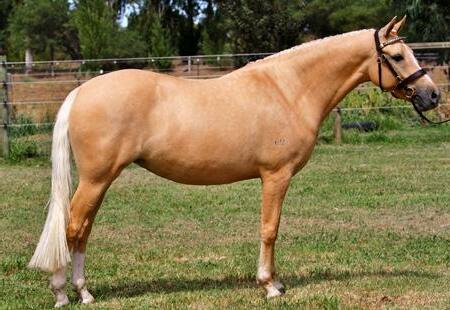
9 minute read
Getting to the pointy end
Goldenero IIU by WES Donadoni out of Golden Dancer, an Elite Westphalien mare (Image courtesy of Deveron Stud).
after for both children and small adults.
Breeders later became interested in creating the ideal dressage pony and their attention turned to the German Riding Pony (GRP), which is possessed of a slightly sturdier build but still with elegant movement and striking ridden performance. When the first GRP, FS Golden Storm, was imported to Australia in 2004 he caught the eye of many breeders. He sired a number of foals but was gelded several years later.
Then in 2008, the first fully licensed GRP stallion, Don Philino WE, arrived to stand at stud in Australia. Sired by Dressman out of a part Warmblood mare by the renowned Hanoverian stallion Luxor, he gave the breeding program the lift it needed. Since then, a number of GRP stallions and mares have been imported, enhancing bloodlines and helping to generate considerable interest in pony dressage events.
Health and feeding
Like many ponies, the Riding Pony can be prone to easy weight gain, but is otherwise normally healthy. Their feeding requirements are relatively simply. They thrive on good pasture and/or hay, with some quality chaff and pony pellets when they’re in work.
Rapid weight gain can lead to laminitis, so while it’s essential to ensure your pony’s nutritional requirements are met, a low sugar diet is probably optimal. You may need to limit their intake of high value pasture (a grazing muzzle might be useful), or if hay fed, soak the hay to reduce calories before offering it in a slow feed hay net to reduce the rate of consumption.
General characteristics
A Riding Pony can be any solid colour, but paints are not acceptable. Overall, the look is elegant with finely chiselled yet sturdy legs, a long and slightly crested neck, and an unmistakeably ‘pony’ head with flat forehead and large dark eyes. The chest should be deep and the shoulders flat but sloping. While the back is short, it should be well-coupled with enough scope to carry a saddle. The hooves are strong and neat, the coat silky with no leg feathering. A straight and smooth, free-flowing action is coupled with a calm and trainable temperament.
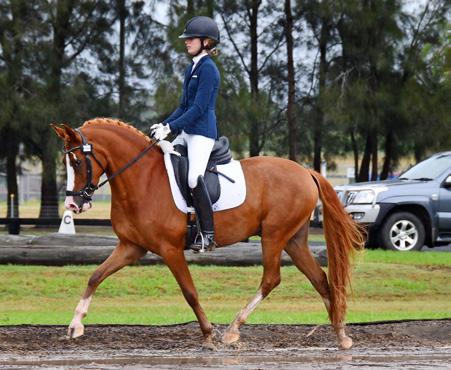
Interested in learning more?
To find out more about Australian Riding Ponies, visit the Riding Pony Stud Book Society. They have an informative website – www.rpsbs.com.au – which includes an extensive stallion directory, or for the German Riding Pony, go to www.germanridingpony.com.au. Deveron Stud specialise in German Riding Ponies, and can be contacted on 03 5852 1871, or visit www.deversonstud.homestead.com – while Whitmere Stud, the Australian Riding Pony breeders, can be contacted on 0405 201 232.
Deveron Lets Dance ridden by Georgia Davenport winning at his second outing under saddle at Clarendon 2019 (Image courtesy of Nicole Davenport).

Accullenitis vellant labo. Officias sustinc ipient facimpe vererro quibusae. Ficimol orporrum lamus dolendi aboris earum sitatquis ut laut velecta turione ctiusam, tore conet iligent que sunt dolupta tecupta vernatus ea core volorit alitata quidebit qui
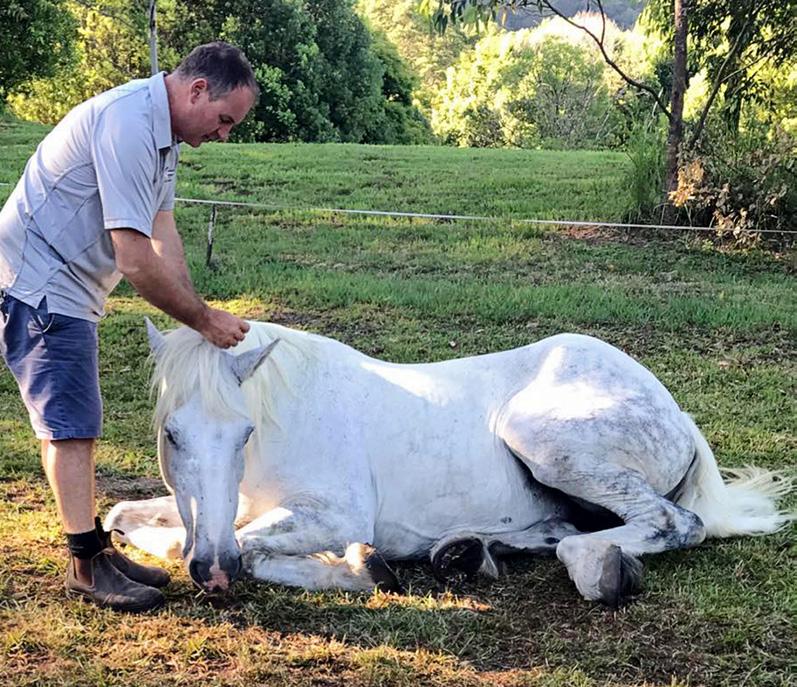
FEATURE
Getting to the pointy end
Equine acupuncturist BEN WALDER has a rather different approach to treating injured and sick horses. While this modality is not a cure-all, some of his success stories are truly remarkable.
Let’s get straight to the point – what is acupuncture? The short answer: it’s an ancient Chinese medicine approach to healing in which a variety of conditions are treated by inserting very fine needles into particular points in nerve-rich areas of the skin. The theory is that the needles create tiny injuries at the insertion site, which, although causing little or no discomfort, are enough to trigger a response from the body. Essentially, the immune system is stimulated, circulation to the area is improved, and injuries and chronic conditions are said to benefit.
Ben Walder, who has been an equine acupuncturist for ten years, explains the process in more detail: “When I find a really sore point on a horse,
that’s where I’ll generally insert the needle. Acupuncture works on meridian channels, which according to Chinese philosophy are the networks our energy flows along. The Chinese call that energy ‘qi’ (pronounced chee). So when I put a needle in a horse that’s the area where there’s a blockage, which causes the horse’s energy to slow down, which in turn can affect the organs ‘fed’ by that meridian channel. The acupuncture needles stimulate the area, encouraging blood and qi energy to flow again. It’s very similar, if not the same, to the way acupuncture works with humans.”
It’s not unusual for Ben to get called out as a last resort, something he responds to with great good humour: “Owners will change their horse’s feed, they’ll change their shoes, do saddle fittings, change their bits, basically they’ll change everything they think needs to be changed. While those changes may help to relieve whatever the problem is, it’s not getting to the underlying issue.”
Ben believes that there’s a beneficial connection between acupuncture and chiropractic work. “You’ll find the advantage is that acupuncture gets the body to rebalance and relax certain areas that have become overly tight – tension in the sacroiliac (the joint between the pelvis and spine), the back, shoulder, or the neck, for example. So when the chiropractor comes along, the horse is relaxed and can be adjusted more easily. It’s actually a soft adjustment rather than a hard adjustment, which is a definite positive. The two modalities are a great combination. An equine chiropractor I know can tell which horses I’ve treated because they adjust so much better.”
Often during an acupuncture treatment, horses will put themselves back in as Ben works on them: “I can actually hear whatever was out of alignment clicking back in,” he says. idea may seem a tad odd – but Ben can tell you a few tales that may well change your mind. “I once worked on a horse owned by a woman who was considering putting him down because he’d become too dangerous to ride. While previously he’d had a kind temperament, now she had trouble going near him, couldn’t ride him, he just wouldn’t behave himself. When I did the first treatment, he literally dragged me 200 meters up the paddock.”
When Ben returned the following week for the second treatment, the horse was some distance away up in the paddock. Saying she would bring him back down, the owner began walking towards the horse who was sleeping on the ground, something he hadn’t done in a long time. But as she approached, he awoke, and looked up at the gate where Ben was standing: “The next minute he got up, pushed his owner out of the way, ran up to me and put his head on my shoulder,” he says with a smile.
Ben spent another six months working with the horse, giving him fortnightly treatments – but it was within just three treatments that his previously kind nature began to return. His owner was able to start riding him again, even taking him campdrafting. “Basically we turned him right around from a horse that was going to be put down to a horse that was doing everything for the owner,” Ben says, “but unfortunately she didn’t keep up with the treatments and eventually he reverted to a really bad state.”
Which brings us to an interesting question: once acupuncture therapy has started, is it always necessary to continue the treatments, and if so, how regularly? “That depends on the horse,” Ben explains. “Just like a person, every horse is different. Some horses need regular once weekly work, while for others once a month, or as needed, is quite enough. I usually suggest to owners that every two to four weeks is a good time frame for treatments, but that can also depend on what the horse is doing. For example, with racehorses I’ll treat them either once a week or once a fortnight, depending on the horse, and of course on what the owner or trainer wants done. With horses that are doing a lot of dressage, jumping, or show hacking, it’s generally every fortnight or every three weeks.”
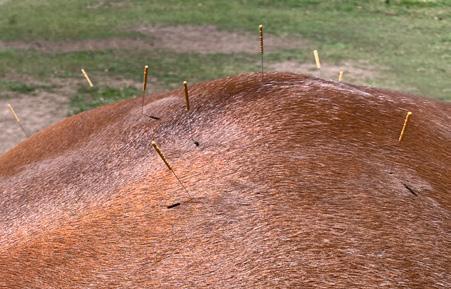
ABOVE: Acupuncture for sacroiliac issues, often called hunter’s bump. Problems in this area are usually caused either by a fall, or too much circling work as a young horse. Alternatively, it can be the result of a genetic breeding problem.
LEFT: Ben at work. Many horses appear to enjoy acupuncture, becoming very relaxed while the treatment is in progress (Images by Ben Walder).
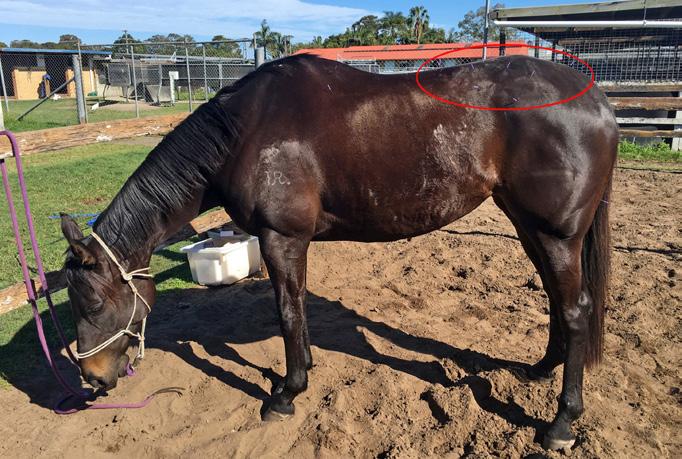
So relaxed was this racehorse that she fell asleep while being treated for stiffness in her pelvic area, which was affecting movement in her right hind leg (Image by Ben Walder).
And in case you’re wondering, Ben treats every type of horse: paddock ponies, champion cutting horses, Grand Prix dressage horses, million dollar racehorses – they all benefit from Ben’s skills.
Take for example a racehorse who consistently trailed towards the back of the field. Realising that the horse was quite sore, Ben initially suggested a change of diet to allow him to detox. After finding a number of issues during the first treatment, he recommended that the horse be rested for seven to ten days, during which he would return for another two treatments. “Four days later, I went back and already there was a change. During the first treatment, the horse had been lethargic and had stood without moving, but during the second treatment, he started to get a bit narky with me,” Ben recalls. was unmistakable! In his first run following treatment, the horse placed second. Another treatment followed a week later, and the horse ran another second, this time only a nose length off the winning post. He followed this up with a first place and four seconds, at which point his owner decided treatments were no longer necessary. The horse responded by running fifth! Not surprisingly, treatments were resumed and he once again placed first.
So how does Ben decide where the acupuncture needles should be placed? “I watch to see how the horse walks and stands, and that gives me a good indication. If they’re not standing square that tells me straight away that there’s a problem. But I also use my intuition - I run my hands over the horse and find points that I think might be a problem. Just by looking and feeling I get a clear idea. So unless I’m dealing with a specific problem, nearly all my acupuncture treatments are based on my intuition. It comes naturally to me. I was a massage therapist for 18 years, working on up to 40 people a week – and that was intuitive massage. A lot of people came to see me almost as a last resort. I’d treat them and they’d be amazed that their problem would be fixed.”










